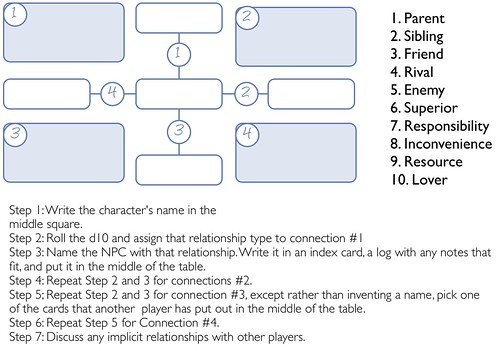I called this out as too long for twitters, so here it is.
In Everway, Jonathan Tweet laid out a model for resolution of uncertainty in RPGs that’s been pretty foundational to a lot of thinking. Basically, when faced with a moment of uncertainty (such as a conflict) there are three factors that play into resolving it.
The first (Karma) could broadly be described as capability, which can include situational elements in the fiction (you’re attacking someone from surprise) or mechanical differentiators (You have a higher sword skill than the guy you’re fighting.). Basically, it’s rules + situation.
The second (Fortune) is luck, generally represented by dice, but sometimes by other approaches.
The last (Drama) is a question of what would be the most _interesting_ outcome of this situation, according to whatever priorities are in play (Most commonly, “what would make a better story?”)
There’s no right answer to how these should be combined and prioritized – the categories are just useful for discussing what different systems take advantage of.
Now, a certain kind of anime throws this for a loop, specifically, the broad swath of anime centered around fights. I’ve touched on this, but I want to call it out specifically – the bulk of anime fights _look_ like they’re determined by Karma (in the form of strength and cool powers) or maybe drama (because the hero has to win eventually) but their specific frame is about Will. The hero wins because his will to win is strongest. This might be an avenue for revealing things about the character (such as why they need to fight) or valuable lessons (I’m fighting for my friends, that gives me strength) but nothing demands that be the case.
This is kind of messed up. It’s got a slightly creepy will to power vibe coupled with what is a kind of immature idea that whoever wants it more gets it, not because that want has made them work harder or prepare better, but simply because they want it more.
On a practical level, this is really problematic in play because while players can conceive of a failure in capability, it is very hard for them to conceive of a failure of will. Yes, there are exceptions, but the player willing to say “My character gives up” is a rare thing. It also makes inter-party conflict kind of lame.
Now, yes, you can mechanize will, make it a pool, blah blah blah, but doing so misses the point of why this is viscerally appealing. We like the idea that sheer gumption can carry the day. It’s kind of like lottery thinking, since it’s a path to victory without the boring stuff, like work, and games are about avoiding the boring stuff, right?
Well, yes. In general. But the absence of pushback, resistance and other “boring” things makes for a kind of unsatisfying game.
All of which is to say, that fighty anime remains a great source for inspiration. I’d love to try powers systems as colorful and elegant as many of those I see on the screen. But emulating it is much harder than it looks at first glance.
(QUALIFIER: As with all anime, all generalizations fail. I tried to address this by narrowing scope, but if you need to pick that nit, pretend that I have explicitly been talking about Bleach, and frame your critiques in that context.)
